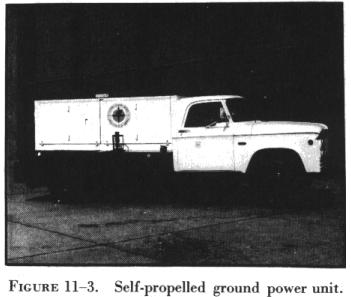Ground support electrical power units vary widely in size and type. Generally, they can be classified as either towed or self-propelled items of equipment.
The towed power units vary in size and range of available power. The
smallest units are simply high capacity batteries used to start light aircraft.
These units are normally mounted on wheels or skids and are equipped with
an extra long electrical line terminated in a suitable plugin adapter.
Larger units (figure 11-2) are equipped with generators. These units provide
a wider range of output power.


Such power units are normally designed to supply constant current, variable voltage dc electrical power for starting jet aircraft engines, and constant voltage direct current for starting reciprocating aircraft engines. This type of vehicle is normally somewhat top heavy and possesses a large inertia; consequently, it should be towed at restricted speeds, and sharp turns should be avoided. Selfpropelled power units are normally more expensive than the towed units and in most instances supply a wider range of output voltages and frequencies. For example, the selfpropelled power unit shown in figure 11-3 is capable of supplying dc power in varying amounts, as well as 115/200 volt, 3 phase, 400 cycle ac power continuously for 5 minutes.